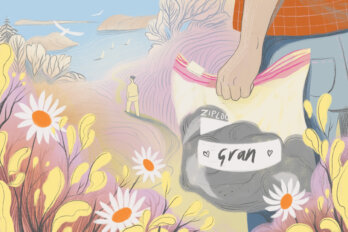The first time I noticed nudists was during a walk through Berlin’s largest park. There were dozens of them, sprawled out in the sun, sipping beers and grilling wurst on portable barbecues. Some were old enough to be my grandparents, with droopy breasts and back rolls, while others were in their twenties, parading hairy chests and tufts of pubic hair. There was even a family or two out with their kids. I was the only one around who turned their head to get a second look.
I’d moved to Germany from Toronto a few weeks earlier, hoping to experience a different way of life. It didn’t take long to learn that, over here, encountering a nudist is about as ordinary as spotting a squirrel. I started seeing carefree naked bodies frolicking at lakes and dance clubs. I even came across a handful of housing ads seeking roommates for “textile-free” flat shares. While discussing public nudity in German class, my twentysomething teacher mentioned that she goes to the sauna with her colleagues. I barely felt comfortable taking my pants off at the gynecologist’s; there was no way I’d try “team bonding” by letting it all hang out in a steam room with the people I usually see buttoned up in office clothes. I was equally mortified after watching the Berlin episode of CNN’s docuseries Sex and Love Around the World, in which a middle-aged East Berliner casually says that the first time his girlfriend met his parents, they were naked—and so was she. “It’s really weird,” replied the interviewer. “It was on the beach,” he said, shrugging. “It was normal.”
In small-town Ontario, where I grew up, nudity is almost always a private affair. Sure, there are a number of nude beaches across the US and Canada, and both countries boast several naturist societies and groups for those who prefer to socialize without any clothes. But, outside of those settings, it’s often associated with intimacy or uncomfortable doctor’s appointments. In Canada, where public nudity is considered an offence “against public decency,” the act can carry a fine of $5,000, six months in jail, or both—which is a shame since studies have shown that spending more time in the nude has both psychological and physical health benefits.
According to a series of surveys conducted by researchers at the University of London, not only did those who engaged in naturism have higher levels of self-esteem and life satisfaction than their clothed counterparts, they also became even happier as they participated in those activities more frequently.
All this made me wonder, Could I, a stuffy Canadian with lifelong body hang-ups, be brave enough to join the beer-sipping, wurst-grilling sunbathers? Living in a pseudo naturist commune or attending a nude parental meet-and-greet felt a stretch beyond my comfort zone, but two months into my new German life, I decided to get over my fear.
I was at a lake with my cousin, who had come to visit over summer holidays. I assured her that “this is just what people do here.” A group of women near us had already removed their swimsuits. We hesitantly followed, darting toward the water with our hands clasped over our chests. Nobody cared, but it still felt wrong—like we were committing some sort of heinous crime against modesty. Our foray into naturism lasted all but a few minutes before we awkwardly waddled back to shore. As soon as we got there, I swiftly scooped up my towel, wanting to cover up my patches of cellulite.
Germans have been practising Freikörperkultur (FKK), or free body culture, for more than a century. Its origins are suspected to have ties to the natural healing movement in the late 1800s, when spa towns began popping up around Germany and the former Austro-Hungarian Empire. It was here that people could free themselves from the constraints of their corsets and waistcoats and let their bodies breathe. After a years-long nudist hiatus throughout the Nazi regime, FKK returned in the postwar era, when it became an act of resistance against a repressive state—especially in East Germany—and persists to this day. Throughout the many phases of the movement, the core idea has remained the same: nudity isn’t meant to be sexual.
By comparison, naturism was much slower to gain traction in Canada. During the industrial revolution in Europe—when factory workers were living in crowded cities and urban areas were rapidly expanding—there was more desire for designated spaces where people could escape to nature and spend time in the nude. Because of Canada’s rural landscape and sparse population, those who wanted to skinny dip or hike naked didn’t need a club to do it. Things began to change following the influx of immigrants—specifically Germans—who settled in southern Ontario after the Second World War. “That’s when Canada became a lot more urbanized, and it’s also when many early nudist clubs started emerging on the edges of major cities,” says Mary-Ann Shantz, a Carleton PhD graduate who studied the history of social nudism in Canada. Similarly, American nudism developed in rural areas, away from peering neighbours and police.
In the 1950s, many of these clubs were run by German couples and catered to other Europeans, but as immigration started to slow, there was an uptick in Canadian-born members. “They tried to convince people that nudism contributed to strengthening heterosexual marriage and that it was a good way to raise children who are comfortable in their own skin,” says Shantz. The goal, she explains, was to make public nudity seem acceptable. Nudism was held up as a leisure activity that families could do together and a way to cultivate emotional intimacy between couples. “They really wanted to sell it as a social good that was going to enhance social norms and community values, not disrupt them.”
The major difference between Canada’s club movement and Germany’s FKK was that Canadian nudists were still practising behind fences and closed doors, mainly on private properties. It wasn’t until the late 1960s, when nude beaches started popping up in places such as California and Vancouver, that the debate began to shift toward public nudity. But North America’s nudists never really entered the mainstream, Shantz explains, and the movement’s growth fizzled out after the ’70s. The topic continues to be a controversial one since, in Canada and the US, nudity is often viewed as sexual.
Media and queer theory researcher Rob Cover writes that, “for contemporary postmodern western culture, sex and sexuality have become significant motifs in advertising, art, entertainment and other frames such that sexuality seems an external force.” For those like me, who didn’t grow up in a place where nudity was considered the norm, seeing a naked body was almost always associated with sex: sixty-second bedroom scenes in R-rated movies, risqué advertisements (where sex sells), and Barbie-like figures in bad internet porn. Germany isn’t a safe haven from dirty films or sultry billboards, but the key difference is that, here, remarkably ordinary naked people exist outside of the pop culture bubble.
The world got a glimpse of this last summer, after a nude German sunbather was photographed chasing a wild boar that stole his laptop bag. It’s hard not to laugh at the images: the man, with his protruding belly and greying hair, looks as though he’s trying to make a desperate plea with the thief while bystanders sit idly by, grinning from ear to ear. Most people would agree that there’s nothing erotic about this scene. Had it happened back home, however, the man could have been charged with committing an indecent act, which Canada’s Criminal Code defines as an act “in any place with intent to insult or offend any person.” (Odds are, he didn’t even intend to go streaking on that fateful day.) According to the Criminal Code, a naked body is, in most contexts, automatically considered offensive.
This probably explains why I felt so prudish during that first-ever skinny dip. A lifetime of being told to cover up made me feel self-conscious. And how could it not? It’s difficult to avoid insecurity standing in front of a mirror, let alone a park full of strangers, when the types of naked bodies you’re used to seeing all look the same. My Instagram feed, especially in the summer, is filled with photos of bikini-clad women who resemble Sports Illustrated models: they’re either tiny and toned, with glistening abs and thigh gaps, or curvy in all the right places. For these types of bodies—those we deem sexy or desirable—nudity is tolerated. I, on the other hand, have squishy bits and stretch marks—both attributes that are expected to remain hidden.
Despite my best efforts to unfollow influencer accounts and curate an online life that feels closer to reality, Instagram continues to push these images my way, and its algorithm still favours thinness above all else. Last year, when Australian comedian Celeste Barber posted a photo mimicking Victoria’s Secret model Candice Swanepoel, it was quickly removed for going against Instagram’s community guidelines on nudity or sexual activity—while Swanepoel’s original remained untouched. Their poses were nearly identical, with both women tilting their gazes toward the sky and clutching their right boobs. The only difference was that Barber appears to be a few sizes larger. Similarly, Instagram threatened to close photographer Camille Brandon’s body-positive account, where she posts nude images of plus-size women, on two separate occasions. “You would never see Kim Kardashian threatened with having her account removed,” she told ABC News last year. “I think it is important for everyone to be exposed to natural and normal bodies.” Once different kinds of nudity start to become more tolerated in the online world, seeing real bodies outside of familiar contexts may not seem quite as jarring.
A decade ago, a team of researchers from Yale University and the University of North California at Chapel Hill tried to better understand how we perceive nudity. During the experiment, participants were asked to look at two sets of photos—one featuring a man, the other a woman. Each set contained both a headshot and a PG-13 bathing suit photo taken from the waist up. While evaluating the subjects’ faces, the study’s participants concluded that both had a lot of agency (capacities such as self control, planning, and morals). As soon as more skin was revealed, however, their perceptions changed, and suddenly the same subjects were presumed to be filled with experience-related capacities like hunger and desire. One analysis of the study concluded that, “when we see a sexualised photo of something, our bodies take over and we subsequently see that person as a means of fulfilling our sexual desires . . . rather than a living, thinking human being.” In other words, North Americans have been wired to automatically interpret bare skin as something scandalous—regardless of whether it’s a movie star or a middle-aged German running around in his birthday suit.
This way of thinking has had real world repercussions that go beyond inconveniencing North America’s closeted nudists. An Arizona couple found themselves in the middle of a decade-long court battle after trying to develop photos of their three daughters—then five months, four months, and eighteen months old—playing in the bathtub. A Walmart employee flagged the photos as pornographic, which launched a full-blown investigation into whether the parents were child sex offenders. In 2018, the court finally ruled, unsurprisingly, that there had been no wrongdoing. Photos like this likely exist in every family photo album, but this case is not an outlier—there have been others just like it. Cover argues that now even the simple record of nudity can be characterized as obscene because it sexualizes the subject. But this is still the fault of the observer. It’s our own gaze, he writes, that makes nudity sexual, not the act of being naked in itself. “I suggest it would be productive to consider a refiguring of sexuality altogether.”
Sex is all about context, and as Cover suggests, it requires a disassociation with genitalia. This idea isn’t new. It’s what movements like #FreeTheNipple—which criticizes the hypocrisy of men being able to enjoy toplessness while women are sexualized and censored—were built on. For that middle-aged East Berliner who introduced his girlfriend to his parents in the nude, or for my German teacher who visits the sauna with her coworkers, these scenarios are unsexy because body parts are features that can be as ordinary and inoffensive as having blue eyes or long hair. If there were a thrusting conga line or a steam room orgy, that would be a different story.
It took time, but eventually, stripping down in public started to feel as ordinary to me as taking off a jacket when it’s too hot outside. These days, I rarely wear a bathing suit at the lake, and my preferred dress code on the dance floor is topless. Apart from the odd wide-eyed tourist caught off guard, as I once was, most people remain unfazed. And if they don’t care about the imperfections I spent a lifetime obsessing over, why should I?
I can’t help but wonder how different my perspective would be today if I grew up seeing more ordinary people with ordinary bodies. In North America, showing skin is still a privilege afforded to good-looking people, and laws are unlikely to change anytime soon. But, if we could only learn to be a little more comfortable, to look at our physiques as outgrowths of nature instead of as objects designed to arouse and offend, then we might finally understand that everyone has a body worthy of being naked.





